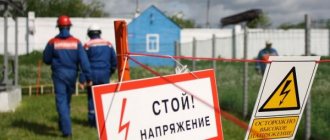Testing knowledge of electrical safety is an event that is mandatory for representatives of a number of specialties. The purpose of the exercise is to ensure safety and prevent the traumatic effects of electricity. Checking is necessary for those employees who will work with electricity.
Question: The company has created a commission to test knowledge in accordance with the Rules for the technical operation of consumer electrical installations. Does this commission have the right to train newly hired employees, assign group II and higher in electrical safety, conduct a knowledge test and make an entry in the certificate? View answer
Employer Responsibilities
The employer has the following responsibilities:
- Organization of safe working conditions.
- Safety training for employees.
- Providing certificates to those employees who have passed certification.
- Organization of regular certifications.
Question: Are there grounds for bringing an organization to administrative liability under Art. 9.11 of the Code of Administrative Offenses of the Russian Federation, if the employee responsible for electrical equipment has not passed the knowledge test in the assigned electrical safety group? View answer
If an employee does not pass the certification, the employer cannot allow him to work until he successfully retakes the test. The head of the company must carry out these activities:
- Approval of a document listing all employees working with electrical equipment.
- Approval of a schedule for testing knowledge on safety when working with electrical equipment. This schedule is transferred to the employee responsible for labor protection.
IMPORTANT! Indirect instructions for ensuring safety when working with electrical installations are contained in Order of the Ministry of Energy No. 261 of June 30, 2003. This order regulates the use of protective equipment that is needed when using electrical installations.
Formation of a commission at an enterprise
For the purpose of conducting certification within the organization, it is necessary to assemble a commission. In this case, there are requirements that establish the required number of workers with the required qualifications. All possible requirements and conditions are specified in the PTEEP. They state that the minimum number of examiners should be five or more.
Group 4 on electrical safety: knowledge testing, requirements for admission
The commission may consist of highly qualified employees. After the meeting of the necessary commission, a document is created, which is certified by the head of the organization. This allows the certification to begin.
Note! The commission is created for a specified period during which its powers last. After the deadline, you must submit an activity report to the director.
Types of electrical safety knowledge tests
Checks are divided into types depending on the frequency of the procedure. Two main varieties:
- Primary. This applies to employees who have just started working. The inspection that is organized after a break of 3 years is also considered primary.
- Periodic. It is carried out once during a certain period (usually short).
Question: The training center has a license, special software, and qualified teachers. What requirements must a training center fulfill in order to create a commission at its base to test knowledge on electrical safety? View answer
Periodic inspection is divided into these types:
- The next one. Conducted once every 12 months for electrical employees (responsible for repairs, electrical installation work), once every 3 years for administrative and technical staff. The difference in the timing is due to the fact that for administrative positions, safety issues when working with electrical equipment are less important.
- Extraordinary. The event is held out of turn when new norms and standards are introduced, when new equipment is installed. The procedure is necessary in case of identified violations of labor protection, recertification, or accidents. She is appointed by decision of government agencies and the conclusion of commissions. You will have to go through the check during a professional break of more than six months.
How to test knowledge of electrical safety of non-electrical personnel ?
There is no need to organize a check in relation to an employee who has been hired for a part-time position. But this is only possible if the following conditions are met:
- A person who previously worked in an administrative and technical position was tested no more than six months ago.
- The energy intensity of electrical equipment is no more than that of the employee’s main position.
- There is no electrical equipment with a voltage greater than 1,000 Volts.
The inspection can be canceled only with the agreement of the State Energy Supervision Service.
When can extraordinary inspections be carried out?
Extraordinary events are appointed in the presence of these circumstances:
- The employee has an expanded list of responsibilities involving the operation of electrical equipment.
- Change of equipment.
- Introduction of new technologies.
- You need to change your access group.
- Poor results were obtained at the last certification or recertification.
The appointment of an extraordinary event does not mean that the next inspection will be cancelled. It is carried out within the established time frame.
The procedure for carrying out the PVZOT
An extraordinary test of employee skills is carried out on the basis that the knowledge of the company's employees was obtained as a result of training. It can be organized at the enterprise itself or on the side of a training company. Training programs are created on the basis of standard provisions that are approved by the Ministry of Labor and Social Protection. This body approves standards for the following positions:
- for directors and deputy directors;
- for individuals who have the status of employers;
- specialists who organize work in the organization and conduct technical supervision;
- employees who work in labor protection services;
- participants in government bodies who are competent in matters of labor protection;
- teaching specialists in organizations where they study in primary, secondary and higher education programs related to labor protection;
- members of commissions that monitor knowledge on labor protection issues;
- members of various mixed groups that deal with labor protection issues.
Note! Thus, programs are drawn up both for ordinary employees and for directors and their deputies
Employee training
Based on rules No. 1/29, employees who have just started working are trained during the first month. Specialists and managers are trained for a month in labor safety standards in relation to their direct responsibilities. Then the procedure is repeated once a year.
Note! Employees of blue-collar professions learn to provide first aid during the first month and are retrained at least once a year. In addition to the general criteria described above regarding working specialties, training and control of knowledge in the field of labor protection is carried out on the basis of industry regulations
In addition to the general criteria described above for blue-collar occupations, training and control of knowledge in the field of labor protection is carried out on the basis of industry regulations.
Organization of inspection
The verification is carried out by the certification commission. The latter is organized for a limited period. Upon completion of its activities, the commission must submit a report on its work to the manager. Its composition is determined by the administration of the enterprise.
It is the commission that needs to prepare a schedule for conducting certification. It is approved by the head of the company. Based on the schedule, knowledge is tested. Not all commission members may be present during the actual certification process. However, there must be a chairman or his deputy present.
Checks are carried out on an individual basis. That is, each individual employee undergoes certification. The list of knowledge that will be tested is established by the head of the organization. The nature of the questions depends on these circumstances:
- Job responsibilities.
- The nature of the work performed.
- List of used regulatory documentation.
Usually, knowledge about the operation of electrical installations, electrical safety rules, and rules for checking the performance of equipment are tested. The employee's knowledge of first aid procedures for electrical accidents is usually confirmed.
Verification can be carried out in various formats. For example, this could be a classic format with exam papers. The examiner may be an electrical safety specialist. But you can replace it with computer programs.
If an employee passes the exam, he is issued a certificate of this. If he fails, recertification is scheduled.
Features of creating a certification commission
The commission is created on the basis, inter alia, of the Order of the Ministry of Energy “On Approval of Rules” No. 6 of January 13, 2003. A commission can be organized only if the enterprise has enough employees with the required qualifications.
Its minimum composition is 5 people. The creation of a commission must be confirmed by an order from the head. Participants receive full certification authority only when this order is signed.
It is required to appoint a chairman of the commission. It must meet a number of requirements. In particular, only an employee with clearance group 5 can become a chairman. Exception: the test is performed for persons working with equipment up to 1,000 Volts. In this case, it is enough for the chairman to have clearance group 4.
IMPORTANT! The chairman cannot have an access group that is smaller than that of the employee undergoing verification.
Rights and obligations of the commission
Approved qualified specialists establish the level of knowledge of hired employees.
Work is determined exclusively on an individual basis:
- Members of the examination group initially form a list of questions that will be asked during testing, referring to their position and work experience.
- The current level of knowledge in the area under consideration is checked. The chairman or his deputy must be present during testing - according to the management, they can conduct testing together.
- Assignment of an electrical safety group based on the results of the passed exam. Based on the results, a decision is made whether to assign a group or not.
- Issuance of a confirmation certificate.
Certificate confirming successful passing of the test
The results of the testing must be recorded in a specially developed internal Protocol. In the event of an unsatisfactory assessment, data about this must also be recorded in the document. As a rule, this entails a retake within the established time frame - until this point the permit is not issued, otherwise the employer will be subject to administrative liability in the form of a fine.
Requirements for employees during inspection
The list of requirements for certification depends on the hazard group to which the employee belongs:
- 1 group. Employees who are not electrical personnel. They work with electric tools, which does not require special knowledge. This category of employees is not tested at all.
- 2nd group. Employees with secondary education who work with electrical equipment. This work is expected to require specialized knowledge. Workers included in group 2 are required to know about electrical installations, dangers when working with electricity, and first aid.
- 3rd group. Electrical personnel working with equipment up to 1,000 volts. He is required to know about the safety standards of the organization. The employee must be able to provide assistance in case of electric shock.
- 4th group. Electrical personnel working with equipment with a power of 1,000 volts or more. An employee included in group 4 must understand electrical installations and be able to manage a team of workers.
- 5 group. This includes employees responsible for electrical equipment. These persons cannot undergo certification at the enterprise. They are checked directly by Gostekhnadzor. These employees must be able to organize safe activities and manage the installation of electrical equipment with any voltage. Representatives of group 5 must also be able to train their subordinates in safety standards.
The greater the responsibility an employee has, the more stringent certification he must undergo.
Personnel categories
For each category of employee there is a recommended electrical safety group.
- Group I. All non-electrical personnel are subject to minimal risk of electrical shock. This group is sufficient for cleaners, office workers, concierges, service workers not related to electricity.
- Group II. The second group should be received by workers who require interaction with electrified equipment: welders, turners, cleaners working in production areas.
- III group. The third group is necessary for employees who provide connection, configuration and maintenance of equipment: electricians, electromechanics, operators of electric furnaces.
- IV group. The fourth group is required for management and supervisory personnel: those responsible for electrical facilities, chief power engineers and engineers, and managers.
- V group. The fifth group is intended for inspectors, engineers and managers of hazardous industries.
Representatives of all groups are required to comply with the frequency of electrical safety certification. Violation of the schedule for representatives of groups II – V is fraught with removal from production.
Test results
The results of the inspection must be reflected in a special journal. It records the rating received by the employee. You also need to record the date of the event and the access group provided. An entry in the journal is certified by the signatures of all commission members.
If the employee receives a positive assessment, he is issued a certification certificate. If an employee is engaged in special work, his certificate must have a corresponding mark. Special work includes these activities:
- Work at a height of more than 5 meters.
- Work in the presence of electrical voltage.
- Testing of equipment with increased voltage.
FOR YOUR INFORMATION! The check can be carried out through computer programs. If the program gives a negative rating, the employee can challenge it.
Categories of employees allowed to work in electrical installations
The internal regulatory documents of the organization must establish a list of positions and functions of personnel who are allowed to work with electricity. Typically this is:
- Administrative and technical staff. He organizes repairs, installation and adjustment of electrical equipment, switching modes if necessary, as well as scheduled maintenance;
- Operational personnel are directly involved in the management of the enterprise’s electrical facilities and maintenance of electrical installations;
- The personnel of the repair departments carry out repairs, installation and reconstruction of electrical equipment;
- The operational and repair category of personnel is exclusively engaged in servicing the relevant equipment.
When applying for a job at an industrial enterprise, each employee undergoes training that allows him to receive the first qualification group in electrical safety. This educational event is often called instruction.
Important! It is recommended to constantly improve the qualifications of personnel operating or maintaining electrical installations. This can significantly reduce the likelihood of injuries and other accidents at work. For example, electrical safety inspectors or heads of relevant departments must take courses at least once every three years.
Contents of the electrical safety briefing
Types of permits for performing work on electrical installations
Who is assigned group 2 electrical safety?
The following list of qualification groups is established by regulatory documents:
- The simplest one is the first one. It is assigned to all categories of personnel who are at risk of electric shock (even those who simply turn on the electric kettle or work at the computer). Obtaining this level of clearance occurs after passing special instructions, and the training must be carried out by a specialist with a clearance group of at least third. To obtain this qualification group, you must answer a number of control questions and demonstrate knowledge of safe work practices and rules for providing first aid in case of electric shock;
- To obtain the second group of admission, you must complete a special course lasting 72 hours or have an electrical engineering education. This qualification level is assigned by decision of the certification commission operating at the production enterprise;
- The list of requirements for obtaining the third group of admission is already more significant. Thus, an employee applying for its assignment must not only have experience in performing various actions within the second group of admission, but also have knowledge of the basics of electrical engineering, labor safety standards and regulations, and know the rules of admission (special safety requirements) for work on electrical installations. He must also be able to control the process of servicing electrical equipment;
Electrical safety approval groups
- To obtain the fourth group of admission, an employee must meet all the requirements established for the previous levels, as well as have a significant theoretical and practical base in the field of electrical engineering, which is tested during the exam. An employee with this qualification group acquires the right to independently train staff and conduct briefings;
- You can get the fifth, highest tolerance group only at Rostechnadzor. It gives the right to carry out almost any activity at electrical installations and manage the relevant personnel. At the same time, we should not forget about responsibility. In the event of an accident or emergency, it is this employee who will bear most of the responsibility.
Additional Information. Administrative liability is provided for violation of labor safety rules. For a responsible employee, the fine can range from 5 to 30 thousand rubles, and for an organization its size can reach 150 thousand rubles. Therefore, significant attention should be paid to compliance with electrical safety requirements and standards.
Thus, a manufacturing enterprise must promptly send its employees to specialized courses and conduct certification of knowledge of labor safety standards in order to avoid possible sanctions. The frequency of electrical safety training is determined by a regulatory document, which must be approved within the organization and drawn up on the basis of the rules for the technical operation of electrical installations and inter-industry rules for the safety of the operation of electrical installations. Responsibility for compliance with the schedule of educational events and the availability of relevant documents lies with the head of the organization and the employee responsible for compliance with labor protection requirements at the enterprise.










